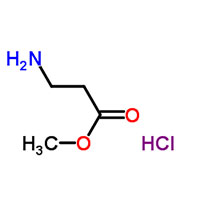β-Alanine methyl ester hydrochloride
Nanjing Finechem Holdings Co., LTD
Synonyms
3-Alanine methyl ester hydrochloride
beta-Alanine methyl ester hydrochloride
Methyl 3-Aminopropionate Hydrochloride
methyl 3-aminopropanoate hydrochloride
3-Aminopropionic Acid Methyl Ester Hydrochloride
h-b-ala-ome hcl
H-Beta-Ala-OMe.HCl
β-Alanine methyl ester hydrochloride
b-Alanine methyl ester HCl
β-Alanine, methyl ester, hydrochloride (1:1)
H-Beta-Ala-Ome,HCl
H-|A-Ala-OMe.HCl
Methyl3-aminopropionatehydrochloride
Methyl β-alaninate hydrochloride (1:1)
MFCD00039060
Product Description
Introduction:
β-Alanine Methyl Ester Hydrochloride is a chemical compound belonging to the group of amino acids. It is
a derivative of β-alanine, a non-essential amino acid that plays a crucial role in various physiological
processes. This product is widely used in the pharmaceutical, food, and sports nutrition industries due
to its unique properties and potential applications.
Raw Materials:
β-Alanine Methyl Ester Hydrochloride is synthesized using high-quality raw materials, including
β-alanine and methyl ester hydrochloride. β-alanine can be obtained from natural sources or synthesized
through chemical processes, ensuring its purity and effectiveness. Methyl ester hydrochloride is
obtained through appropriate reactions and subsequent purification steps, ensuring the desired quality
of the final product.
Production Process:
The production of β-Alanine Methyl Ester Hydrochloride involves a series of carefully controlled steps
to ensure consistent product quality. The synthesis begins with the extraction or synthesis of
β-alanine, which is then reacted with methyl ester hydrochloride under specific conditions. The reaction
mixture is purified using techniques such as filtration, crystallization, and drying, resulting in a
white crystalline powder as the final product.
Market Trends:
β-Alanine Methyl Ester Hydrochloride has gained significant attention in recent years due to its
potential applications in various industries. In the pharmaceutical sector, it is used as a precursor in
the synthesis of pharmaceutical compounds and as a component in drug formulations. In the food industry,
it is used as a functional ingredient in dietary supplements and sports nutrition products. The growing
interest in sports performance and fitness has also contributed to the increased demand for β-Alanine
Methyl Ester Hydrochloride in the sports nutrition market.
Amino Acid Status:
β-Alanine Methyl Ester Hydrochloride offers unique advantages as an amino acid derivative. β-alanine
itself is a non-essential amino acid, meaning it can be synthesized by the body. However,
supplementation with β-Alanine Methyl Ester Hydrochloride provides an exogenous source of β-alanine,
which can support various physiological processes, particularly those related to exercise performance
and muscle function. Its availability as a supplement allows individuals to conveniently increase their
β-alanine intake and potentially enhance their athletic performance.
Conclusion:
β-Alanine Methyl Ester Hydrochloride is a versatile chemical compound with various applications in the
pharmaceutical, food, and sports nutrition industries. Its synthesis from high-quality raw materials and
stringent production processes ensure consistent product quality. The market demand for this product is
expected to continue growing due to its unique properties and potential benefits. With its potential
effects on sports performance and muscle function, β-Alanine Methyl Ester Hydrochloride offers a
valuable option for formulation and application in different industries.





